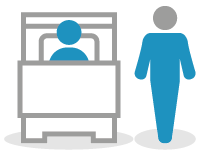Haematology is the study of the cause, diagnosis, treatment and prevention of diseases related to blood. It involves the production of blood and its components, such as blood cells, haemoglobin, blood proteins and bone marrow.
Haematology Staff
Haematologists investigate, diagnose and treat diseases such as anaemia, leukaemia and lymphoma. They also care for patients with blood-clotting abnormalities and are responsible for ensuring that blood transfusions are safe and available when they are needed.
Haematologists can be biomedical scientists and clinical scientists who work in laboratories as well as medical staff who work with patients in clinics and on the wards. They can be involved throughout the patient’s journey, from the first hospital visit, through laboratory diagnosis to treatment.
Hundreds of thousands of blood tests are done every day in the UK.
Haemostasis (Blood Coagulation)
Haemostasis is the human body’s response to blood vessel injury and bleeding. It involves a coordinated effort between platelets and numerous blood clotting proteins (or factors), resulting in the formation of a blood clot and subsequent stopping of the bleed.
Blood Transfusion
Blood transfusion is the process of receiving blood or blood products.
Transfusions are used for various medical conditions to replace lost components of the blood. Blood transfusion uses individual components of the blood, such as red blood cells, white blood cells, plasma, clotting factors and platelets.
Our Programme
Assessment: all SWMS patients will undergo an initial assessment.
Treatment: SWMS is a structured education programme.
Assessment
Patients referred to SWMS will undergo an initial assessment. They will be asked to complete a questionnaire prior to the assessment. The assessment will cover a variety of areas that we know can influence your weight management, including questions about:
- Diet and weight history
- Health conditions
- Activity levels
- Mood and well being
- Motivation
The initial assessment allows us to direct you towards the best treatment plan for you. This may include further assessment with a Clinical Psychologist and/or a Physiotherapist.
Treatment
The SWMS is a structured lifestyle education programme delivered by a specialist multi-disciplinary team. This is primarily delivered in groups which are currently delivered online.
Some patients may be offered a 1:1 approach following assessment based on clinical need.
Our programme offers expert advice on diet, nutrition and physical activity, underpinned by psychological theory to support patients with their long term lifestyle change.
The standard SWMS programme aims to support weight loss and long-term weight maintenance. The specialist team will give advice and support with:
- Psychological strategies
- Physical activity guidance
- Individual dietary
- Lifestyle advice
All advice is tailored to the individual patient and take into consideration any severe and complex health conditions that may have an impact on their ability to make the necessary changes.
More Information
The ‘Enhanced Recovery After Surgery Programme’ (ERAS) refers to the processes in place to ensure that patients are ready for their surgery and receive the care they need to get back to the comfort of their own home, as quickly as possible.
A huge part of improving a patient’s recovery after surgery is making sure they have a good understanding of what to expect before coming into the hospital. This website, information leaflets and appointments with the staff in the hospital are all opportunities to find out what will happen when you come into the hospital and how to prepare for it.
Preparing for surgery
An operation and the healing process can place high physical demands on the body. In the weeks and months before an operation, you can take action to improve your health and fitness in preparation for surgery. If you do this then you will be back to your normal self, much quicker.
During and after your surgery
We make sure all patients get the same high level of care during their anaesthetic, surgery and afterwards on the ward, so we can get you back on your feet as soon as possible.
Physiotherapists and nursing will do this by:
- Getting you out of bed, with the help of the staff, soon after surgery
- Encourage you to eat and drink normally
- Dressing you into your own clothes
- Getting you home as soon as possible
This will all help to get your recovery off to the best possible start and not increase the risk of any complications.
The sooner you can get moving and get back on your feet the better the result from your surgery. It can also helps reduce discomfort, if you have had a hip or knee replacement surgery.
We will ensure you have plenty of medication available to help ease the pain when you need it. In most cases, the discomfort significantly improves after only a few days.
When you come into the hospital, we’ll tell you how long your hospital stay is likely to be, so you know what to expect.
The planned duration of stay will vary depending on the specifics of your operation and which hospital you are attending. We will assess you regularly after your surgery to check how you are progressing and to check for any complications.
We will discharge you home when you are ready, even if this is earlier than the planned date. However, if you need a little more help don’t worry, we won’t discharge you until you are ready.
An electrocardiogram (ECG) records the rhythm and electrical activity of your heart. ECG’s can often be done by your GP (family doctor) if he/she suspects that you might have heart disease or you may be referred to your local hospital to have an ECG done.
What to expect when you have an ECG
You will have several small sticky patches (electrodes) placed on your arms, legs and chest. These patches are connected to an ‘ECG recorder’ which picks up the electrical signals produced with each heart beat so that a ‘heart trace’ can be recorded.
The test is quick and painless and is important for spotting any irregular heartbeats, such as it beating too fast.
An ECG can show if you have had a heart attack or problems with your heart rhythm but, other tests may be required to make certain.
Exercise ECG (ETT)
Some patients will be given an exercise ECG. This test is the same as the EGC but you will be asked to walk on a treadmill. This will start slowly on the level and then gets a bit faster and a bit steeper. Your ‘heart trace’ will be recorded at the same time.
This test helps the doctor decide whether or not it is likely that you have a narrowing in the coronary arteries. If you have a very abnormal Exercise ECG you may be advised to have a coronary angiogram.
Almost all patients with angina or who have had a heart attack, who can walk comfortably on a treadmill, will have a treadmill Exercise ECG test.
If you cannot manage a treadmill test there are other tests that can give the doctor similar information.
This webpage provides:
- Information about dietitians and how to access our clinical service
- Nutritional information and advice that can help people to manage their health condition
- Useful information for staff and colleagues.
- Click the button below to download a brief interactive website overview
Webpage Survey
We try to make the website as informative as possible, so would appreciate your thoughts. Please let us know what you think of the webpage and how we can improve it on the evaluation button below. It should only take 2 minutes to complete.
Who are we?
We are a team of dietitians, support workers and administrative staff. Our dietitians assess and treat nutritional and dietary issues in a variety of health care settings, including hospitals and health centres, across the health board area. The paediatric service also provide a Scotland wide service for inherited metabolic diseases and shared care to other areas.
Dietitians are Allied Health Professionals registered with the Health and Care Professions Council (HCPC) who specialise in the assessment and treatment of a wide range of dietary issues for individual people and the wider population. The term “dietitian” is legally protected; only people that are suitably trained and registered with the HCPC can use this title.
What do we do?
A Dietitian will assess your dietary intake and will work with you to develop and agree a treatment plan to help meet your goals in relation to your health concerns. Examples of the benefits of seeing a Dietitian are:
- To reach or maintain a healthy weight
- To resolve symptoms caused by food allergies and / or intolerances
- To live healthily with a long-term condition, e.g. diabetes, coeliac disease, irritable bowel syndrome, cancer, renal disease and weight management advice from the specialist weight management service.
Our governing body is the British Dietetics Association (BDA). See below for more information on dietetics. The site also provides information on a variety of topics including, “How to become a dietitian” and information on self management of certain conditions – see “Food Facts”.
How do you access our service?
You can ask your General Practitioner (GP) or other health care professional to refer you to a dietitian.
If you are under the care of a hospital consultant they, or a specialist nurse attached to the multi-disciplinary service, can also refer you to a dietitian.
About your appointment
Your appointment will either be face to face, by telephone or using NHS Near me video consultation. NHS Near me is new video consultation, more information is available on the button below
What is Colposcopy?
Most patients seen in colposcopy clinics do not have cancer. The aim is to spot and treat abnormalities before they become cancerous. Clinics provide care for women with abnormal cervical smears. They diagnose and treat various conditions including abnormal cells and early cancers of the cervix. They also care for women with other conditions affecting the vulva and vagina.
Colposcopy is an examination to look closely at the cervix (neck of the womb) using a special microscope. Similar examination may be performed at the vulva (vulvoscopy) or vagina (vaginoscopy). Small tissue samples (biopsies) may be taken to check for any pre-cancerous or cancerous change. Treatment for pre-cancerous change can also be done at the same time if needed.
Colposcopy Clinics in NHSGGC
Our clinics mainly provide care for women with abnormal cervical smears. We diagnose and treat various conditions including abnormal cells and early cancers of the cervix. We also care for women with other conditions affecting the vulva and vagina.
Glasgow Clinics
Clyde Clinics
- Royal Alexandra Hospital
- Inverclyde Royal Hospital
- Vale of Leven Hospital
Who needs to be seen in the colposcopy clinic?
Women with:
- abnormal smears
- abnormal cells on their cervix (CIN – Cervical Intra-epithelial Neoplasia) who require treatment
- abnormal looking cervix or symptoms that their GP / nurse thinks requires a second opinion
- suspected or proven vulval abnormalities
What happens in the clinic?
The doctor will check your details and smear history. You will be asked to get changed in a private area and the doctor will examine you on a couch with leg supports.
A speculum will be placed into the vagina (similar to a smear test). A solution will then be applied to the cervix to help show up any abnormalities.
If any abnormality is seen, the doctor may:
Take a biopsy
A tiny sample of the surface of the cervix will be taken and sent to the lab for testing. This may sting briefly.
Offer treatment either at the same appointment or at a later date
For those who need treatment, a local anaesthetic is injected into the cervix (this can sting a little for a very short time), so you will not feel any pain during treatment.
We offer 2 types of treatment:
‘LLETZ’/‘a loop’
- A thin wire is used to remove the abnormal area from the cervix. The tissue removed will be sent away for more tests.
Cold coagulation/‘short heat treatment’
- The abnormal tissue will be burned away by heat and no tissue sample will be sent away with this method
- Our staff will check that you are feeling well after the procedure and offer after-care advice
- The doctor will write to you with the test results. (It is important that we have the right address for you).
Clinic contact details
If you need to contact the clinic for any reason e.g. you are running a little late, the contact number are as follows:
- Royal Alexandra Hospital: 0141 314 6719
- Inverclyde Royal Hospital: 01457 525 411
- Vale of Leven Hospital: 01389 817 275
- Stobhill Hospital: 0141 355 1209
Additional information and support
Further information on smear can be obtained from the NHS Inform Cervical Screening Smear Test webpage.
Further details on colposcopy can be obtained from the NHS Inform Colposcopy webpage.
Useful organisations
For the small number of women who receive a diagnosis of cervical cancer, support and information will have been given by the colposcopy team and your local Clinical Nurse Specialist. Further useful information may be obtained from:
Orthoptists specialise in the assessment, diagnosis, management and monitoring of a variety of eye disorders in both adults and children. The disorders can be caused by issues with the muscles around the eyes, or issues with the nerves enabling the brain to communicate with the eyes.
Orthoptists work with a variety of patients of all ages, including those with neurological conditions such as stroke, brain tumours or multiple sclerosis. They provide a range of treatment and management options for conditions causing blurred, double vision and oscillating vision (where objects appear to move even when they are still).
Many of us take our eyesight for granted, having any of these symptoms can make even simple everyday tasks very difficult and unpleasant, and in some cases unsafe. Patients may be provided with eye patches, eye exercises, prisms or glasses which can help to relieve symptoms and drastically improve quality of life.
The majority of Orthoptists are employed by the NHS in hospitals and community services, working with a wider team alongside Optometrists and Ophthalmologists.
If you are concerned about reduced vision, double vision, see a squint in the eye or changes in lid position then you should contact your GP or local optician for a referral to our service.
How to assess the service
The Orthoptic service operates on a referral system via:
- Local opticians
- General Practitioners (GP)
- Pre-school visual screening
- Health visitors
- Social workers
- Paediatricians
- Internal referral from other departments in the hospital.
NHSGGC Orthoptic departments
Gartnavel General Hospital
Orthoptic clinic is located on the Upper Ground floor
Gartnavel General Hospital
1053 Great Western Road
Glasgow,
G12 ONY
0141 211 1042
Queen Elizabeth Hospital
Orthoptic clinic is located on the 1st floor in clinic I.
Queen Elizabeth Hospital
1345 Govan Road
Glasgow
G51 4TF
0141 201 3156
New Victoria Hospital
Orthoptic clinic is located on the 2nd floor in clinic M.
New Victoria Hospital
52 Grange Road
Glasgow
G42 9LF
0141 347 8516
Institute of Neurological Sciences
Orthoptic clinic is located on the ground floor in area 5
Institute of Neurological Sciences building
Queen Elizabeth Hospital
1345 Govan Road
Glasgow
G51 4TF
Glasgow Royal Infirmary
Glasgow Royal Infirmary
Queen Elizabeth Building
Alexandra Parade
Glasgow
G31 2ER
0141 211 6318/6319
Stobhill Hospital
Orthoptic clinic is located on level 2
Stobhill Hospital
133 Balornock Road
Glasgow
G21 3UW
0141 3551577
Royal Hospital for Children
Orthoptic clinic is located
Royal Hospital for Children
Queen Elizabeth Hospital
1345 Govan Road
Glasgow
G51 4TF
Royal Alexandra Hospital
Orthoptic clinic is located
Royal Alexandra Hospital
Corsebar Road
Paisley
PA2 9PN
0141 314 9706
Inverclyde Royal Hospital
Orthoptic clinic is located
Inverclyde Royal Hospital
Larkfield Road,
Greenock
PA16 OXN
01505 504505
Vale of Leven District Hospital
Orthoptic clinic is located
Main Street
Alexandria
G83 0UA
At around 4-7 months baby’s first tooth should appear. A baby who is attached well at the breast will be unable to bite down when they begin teething. The nipple is positioned far back into his or her mouth and the tongue will cover the lower gum. Ensuring baby is well attached is key.
As babies develop they become more inquisitive:
- Minimize distractions by dimming lights, turning off the TV or playing soothing music
- Try breastfeeding while walking or rocking, or find a quiet place.
Try to ignore other people’s opinions – all that matters is breastfeeding baby for as long as you can to give them the best start.
Reasons to breastfeed for baby
- Immune system – protects against infection and inflammation
- Bladder – protects against urinary infections
- Tummy – protects against serious infections an tummy bugs
- Lungs – less likely to be hospitalised with asthma when they are older
- Teeth – less likely to have tooth decay when they are older
- Ears – protects against ear infections
- Healthy weight – protects against diabetes when they are older.
What to wear when breastfeeding
- You don’t really need to buy anything to breastfeed, however, special nursing bras and ordinary items of clothing can make breastfeeding extra comfortable and easy when on the go.
- A good fitting breastfeeding bra will help to support your breasts and ensure easier access when feeding.
- Getting a new bra.
- Bra should never be so tight that it presses or squeezes breasts
- Under-wired bras are not advised due to the increased chance of blocking ducts and causing pain and inflammation
- Things to look out for in a nursing bra
- Four hook-and-eye fastenings, rather than the normal one or two
- Wider shoulder straps with a broad back and sides
- Cups that you can open and close with one hand
- It’s a good idea to be measured so that you know your bra fits properly
Days out and breastfeeding
Building Confidence
- The more you breastfeed when out and about, the more confident you’ll get
Planning to feed when out and about
- Slings and carriers are a great help for many mums, allowing them to carry their babies close to their bodies.
- This keeps their hands free and makes breastfeeding almost invisible.
- A loose top can enable feeding to be discreet, or a shawl or muslin draped over mum’s shoulder can ensure privacy.
- Attending a local breastfeeding group can be helpful to start feeding out and about as women are surrounded by like-minded mums and will receive support and advice.
Breastfeeding Friendly Scheme
- Breastfeeding friendly welcome schemes are in place throughout Greater Glasgow and Clyde
- The scheme sees stickers displayed to welcome women to breastfeed within premises and staff receiving awareness training.
- Many women report that these schemes helped them cross the threshold from home to out and about and allowed them to see and feel that their community would support their decision to breastfeed their baby.
Legal right to breastfeed
- It is women’s legal right to breastfeed wherever and whenever.
- Protected by the Breastfeeding etc. (Scotland) Act 2005
- It is an offence to stop someone in a public place from feeding their child, if under two, with milk. The legislation allows for fines for preventing breastfeeding in public places.
Why Should I Breastfeed Past 6 Months?
What are the advantages for mum?
- Ongoing breastfeeding reduces the risk of breast and ovarian cancer
- Breastfeeding can help women lose weight by burning up to 500 calories a day.
- Breast milk is safely available at the right temperature whenever and wherever your baby is ready for a feed, making it really convenient.
- Breast milk is, of course, absolutely free and will save you a fortune because it never runs out. As your baby feeds, your body is busy making more milk.
What are the advantages for baby?
- Breast milk changes to meet your baby’s needs as they develop, and can respond to their surroundings to protect them from germs and bugs.
- Beyond the early years, breast milk also improves brain development and your baby’s future health by reducing their chances of conditions such as asthma, diabetes and obesity.
How Can I Prepare for Going Back to Work?
Some women give up on breastfeeding once they return to work,but this doesn’t have to happen.
Employers have a legal duty to support working, breastfeeding mums.
There are laws in place to protect breastfeeding working mums and many employers have special policies to make breastfeeding and expressing in the workplace as easy and as comfortable as possible.
To make sure your employer is ready to support you, you must write to them and let them know that you want to continue breastfeeding when you return to work -the earlier you let them know the better. Your employer will have to carry out a risk assessment to make sure it’s safe for you to breastfeed or express milk at work. Ideally, you should have access to:
- A clean, warm room with a low, comfortable chair. If you can’t lock the door, you should be able to put a sign on it to make sure nobody interrupts you. The toilet isn’t good enough!
- A plug socket point in case you are using an electric breast pump
- Nearby hand washing facilities
- A hygienic area where you can clean your pump and store your equipment
- A fridge for storing milk.
Preparing to Express Breast Milk at Work
- Speak to your childminder or nursery so they know how to store and use your milk.
- Have a chat with your employer -you may need more flexible working hours and breaks to fit with your baby’s feeding patterns.
- Find out more about the protection the Breastfeeding etc. (Scotland) Act 2005 gives you as an employee by following the link below.
Breast Milk Storage and Bottle Hygiene
Just like normal milk, breast milk must be stored carefully to stop it going sour.
Follow these tips to make sure none of your milk goes to waste.
Getting ready to express
- Wash your hands
- Make sure whatever you’re collecting your milk in is very clean and dry (you don’t need to sterilise it though -this is new advice in Scotland)
- Use a different container with a lid to store your milk. Again, check it’s clean and dry
Storage
- Label storage containers with the time and date to make sure you don’t use any spoiled milk
- Store your milk in the fridge or freezer as soon as possible
- Store at the back of the fridge and not in the door, away from meat products, eggs and uncooked food
Breast Milk Storage and Bottle Hygiene
Storage Times and Temperatures
- You can store your breast milk for up to 3 days in a fridge running below 10ºC
- Breast milk stored in a fridge running under 4ºC can be stored between 4 and 8 days
- Freeze your milk if you won’t be using it in time
- Keep an eye on the temperature of your fridge -opening the door frequently can make it rise. If there’s no built in thermometer, borrow or buy a fridge thermometer available from kitchenware stores
- Use a cool bag or box with frozen ice packs to transport milk.
Using Stored Breast Milk
- Defrost frozen milk in the fridge, but if you need it quickly it is safe to defrost under cool, then warm (not hot) running water.
- Dry the outside of the container with a clean towel or kitchen roll before use
- Use stored breast milk straight from the fridge
- To avoid overheating never use a microwave, always heat in warm water
- Use defrosted breast milk immediately -throw away anything unused
- If it smells sour, it has spoiled. Don’t use it!
- When stored the cream and milk may separate out. This doesn’t mean it’s spoiled -just gently mix it before use
- Use a very clean bottle, cup or syringe to feed your baby. There’s no need to sterilise. Just clean everything thoroughly in hot, soapy water and completely air dry, checking there’s no dried in milk or soap left behind.
Diabetes is a lifelong condition that causes a person’s blood glucose (sugar) level to become too high.
There are two main types of diabetes – type 1 diabetes and type 2 diabetes.
Type 2 diabetes is far more common than type 1. In the UK, around 90% of all adults with diabetes have type 2.
Diabetic Retinopathy Screening
Everyone with diabetes runs the risk of developing diabetic retinopathy, a condition that may cause blindness or serious damage to eyesight.
As part of a national screening programme, anyone with diabetes over the age of 12 years is invited to have their eyes checked.
Visit NHSinform Website for more information about the screening programme.
To change your appointment, please phone 0141 277 7417 and one of our staff will be on hand to offer you a more convenient appointment time.
The day surgery unit provides a variety of procedures that can be accommodated as a day case (the patient does not have to be admitted to the hospital overnight).
These procedures may involve local anaesthetic, general anaesthetic or sedation.










